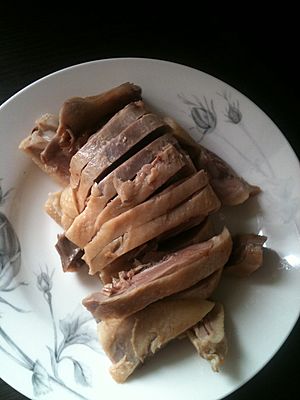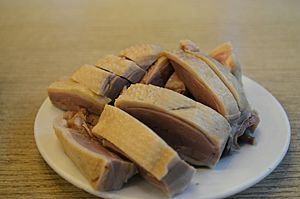Nanjing salted duck facts for kids
Nanjing salted duck (Chinese: 盐水鸭) is a special duck dish from Nanjing, China. This tasty dish has been around for hundreds of years, possibly since the 1300s. It became even more famous during the Qing Dynasty.
The duck meat is soft and white. It has some fat, but it's not greasy. The dish smells wonderful and is often crispy. You can eat it all year, but many people say it tastes best in autumn. This is because ducks in autumn might have a sweet smell from osmanthus flowers. Some shops even add osmanthus to the duck for extra flavor! When made around mid-autumn, it's sometimes called "osmanthus duck."
Nanjing salted duck is often a dish people share. It's a popular food in Nanjing. Locals and visitors often buy it from street shops. Nanjing is known for its amazing food, especially duck dishes. People in Nanjing eat over 100 million ducks every year!
This dish is super popular in southern China, just like Peking duck is in northern China. For people in Nanjing, eating salted duck every day is a common habit. Some historians think people in Nanjing started raising ducks over 2,000 years ago. A famous Chinese food expert, Tongzhi Zhang, even wrote about Nanjing salted duck in his book, List of Jinling’s Delicacies. Many of the best duck shops are in the Shuiximen area. The special taste of Nanjing salted duck comes from how the duck fat changes during cooking. This happens through steps like dry-curing, salting, roasting, and boiling. In some parts of China, people enjoy it with taro.
Contents
History of Nanjing Salted Duck
Cooked duck dishes are very popular in China. They are known for being tasty and healthy. Nanjing, an old city by the Yangtze River, has a long history of raising ducks. Some experts believe people in Nanjing raised ducks over 2,000 years ago.
During the early Ming dynasty (1368-1644), salted duck was a daily meal for many families in Nanjing. Even the emperor at that time, Zhu Yuanzhang, loved it! For people in Nanjing, eating salted duck every day is as normal as having a cold drink in summer. Rich or poor, many people in Nanjing enjoy a plate of salted duck often.
Old Stories About Its Origin
One old story says that Zhu Yuanzhang was emperor in the 1300s. Nanjing was his capital. There was a problem, and he ordered all roosters in the city to be killed. This stopped the noise, but then there was no chicken to eat! So, people in Nanjing started eating more duck. This made duck dishes, like Nanjing salted duck, very popular. Other stories say Nanjing was famous for duck dishes even earlier, around 420-589 A.D.
During the Qing dynasty (1644-1911), many restaurants near the Nanjing Fuzimiao made special brine duck. This was to feed students taking the important imperial examinations.
How It's Made
Making Nanjing salted duck involves several steps. First, the duck is cleaned, and its wings and feet are removed. Then, spices are rubbed all over the duck, and some are even put inside. The duck is then cooked in a pot and pickled for a few hours. After that, it's hung to dry in a place with good air.
Next, the duck is gently cooked in water with ginger, onion, and star anise. Finally, the cooked duck is cut into strips. This careful process gives the duck its special flavor and tender texture.
Special Shops in Shuiximen
Many of the most famous duck shops in Nanjing are in the Shuiximen area. If a shop has "Shuiximen" in its name, it usually means it's very popular! Shops like Shuiximen Xu's Duck and Shuiximen Yin's Duck are well-known. All the duck shops around Shuiximen claim to sell the most authentic Nanjing salted duck.
These shops are busiest in the afternoon. Long lines of customers often form by 3 PM. When the shop opens, one person cuts the duck, and another serves the customers. Most of the salted duck is sold out by 6 PM every day.
When preparing the duck, it goes through a brining step. Some traditional shops don't use gloves for this. They believe touching the duck directly helps spread the salt evenly. This also prevents a rubbery taste. Also, plastic pots are avoided during brining. This is because the duck meat is very tender and its flavor can be easily changed.
Unique Flavor and Cooking Style
Nanjing salted duck is one of China's traditional meat dishes cooked at low temperatures. It's a famous local appetizer, known for its tender and tasty meat. Even though it looks simple, its rich flavor makes it a key part of Nanjing's food. It's as popular and well-loved as Peking duck. Nanjing's food, also called Jinling cuisine, is part of Jiangsu cuisine. This is one of the eight main cuisines of China.
Nanjing salted duck is cooked using a traditional Chinese brine method at low temperatures. This makes it tender and flavorful. Brine is a salty water mixture used to treat raw meat. It helps remove any strong smells and is used for many traditional cooked meats. The flavor is the most important part of Nanjing salted duck.
The duck's fat is important for its unique taste. The fat changes during the cooking process. This happens through steps like dry-curing, salting, roasting, and boiling. These steps help create the special flavor of Nanjing salted duck.
The dry-curing step helps the duck fat change. During the brining step, the whole duck is soaked in aged brine. This is why Nanjing salted duck tastes so good compared to other duck dishes. The best time to age the duck is 24 hours. This helps the duck meat become firmer. If the duck is aged too long, it can lose too much water. This can affect the fat and the final flavor.
In short, the salt in dry-curing makes the taste smooth. Brining makes the flavor stronger. Aging makes the meat firmer. And the final boiling step makes the duck meat even more tender and tasty.
Special Ways to Eat It
Nanjing salted duck is so famous that it has influenced cities like Shanghai and Hangzhou. Just like mashed potatoes and turkey are a classic pair for Thanksgiving in the United States, taro and duck are a perfect match for the Mid-Autumn Festival meal in Shanghai, China.
Many chefs in China have created countless recipes using taro and duck. In eastern China, people often cut up peeled taro, stir-fry it with salt and spring onions. Then, they cook it in a pot with duck bought from a shop. Nanjing salted duck is a popular choice for this dish because of its rich smell and delicious taste. In Guangdong province, people who love soup put taro and duck together in a slow-cooked soup. They believe this soup can help with dryness in the body during autumn.
Awards and Recognition
Nanjing salted duck has received several honors over the years:
- In 2012, it was named a Chinese geographical indication agricultural product. This means it's recognized as a special food from a specific area.
- In 2014, a local newspaper in Nanjing, Modern Express, named Nanjing salted duck as one of the city's eight most popular dishes.
- Also in 2014, during the Youth Olympic Games held in Nanjing, Nanjing salted duck was part of the athletes' meals. This gave athletes from all over the world a chance to try this famous dish from Jiangsu.



